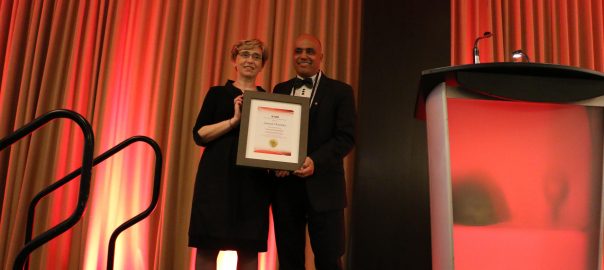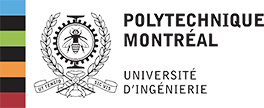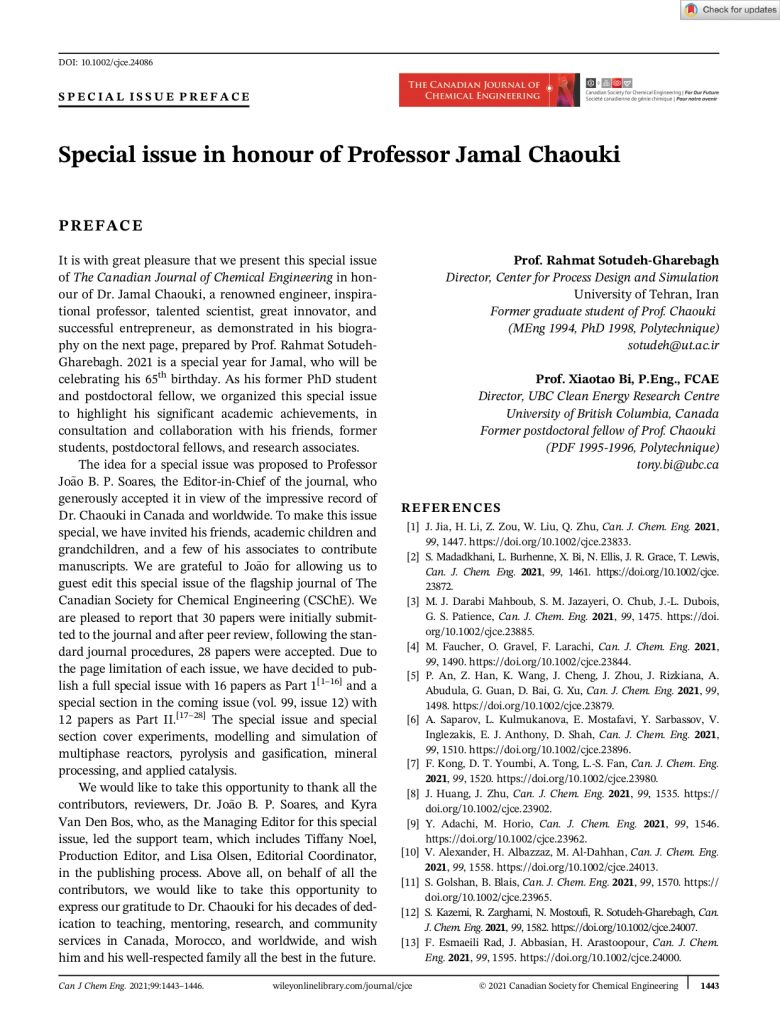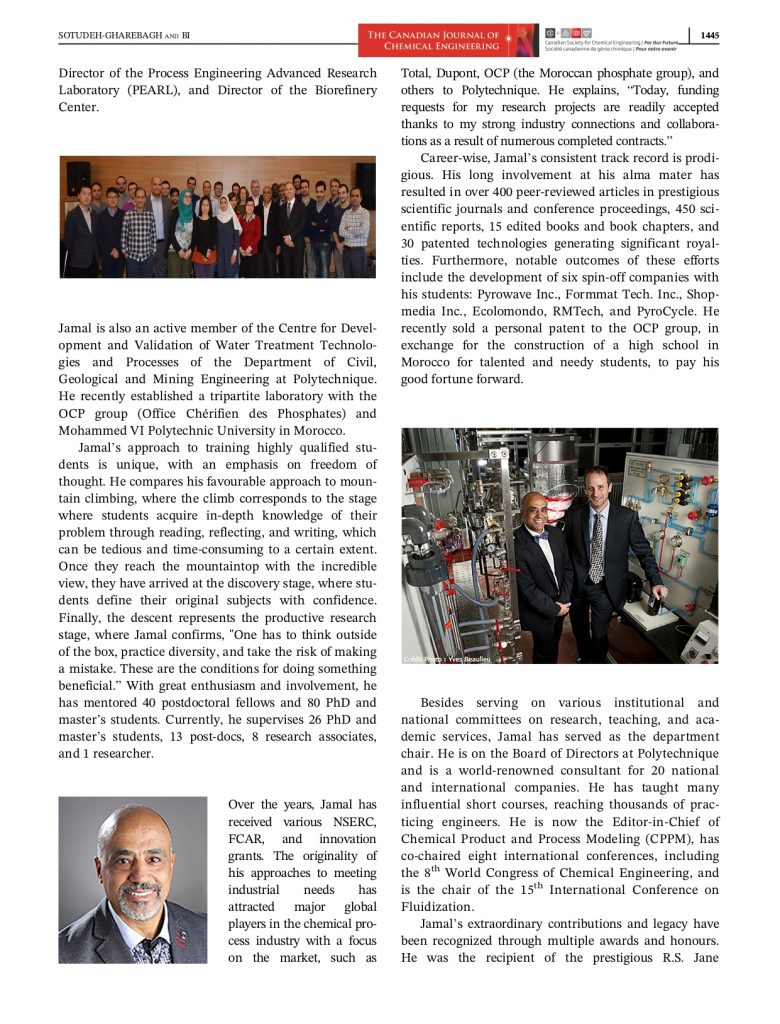July issue of The Canadian Journal of Chemical Engineering as the special issue in honour of Prof. Jamal Chaouki
June 11, 2021

Special issue in honour of Professor Jamal Chaouki
It is with great pleasure to announce that the July 2021 issue of The Canadian Journal of Chemical Engineering is published as the #specialissue in honour of Prof. Jamal Chaouki, a renowned engineer, inspirational professor, talented scientist, great innovator, and successful entrepreneur, prepared by Prof. Rahmat Sotudeh- Gharebagh. 2021 is a special year for Jamal, who will be celebrating his 65th birthday. As his former PhD student and postdoctoral fellow, we organized this special issue to highlight his significant academic achievements, in consultation and collaboration with his friends, former students, postdoctoral fellows, and research associates.
AWARD OF EXCELLENCE IN RESEARCH AND INNOVATION 2019
July 24, 2019

Professor Jamal Chaouki, the head of PEARL, was recognized as an exceptional researcher and outstanding teacher. He received this award during the convocation of graduate students of UdeM and Ecole Polytechnique of Montreal Universities. He graduated in 1980 from the National School of Chemical Industries in Nancy, France. He, also, holds a master's and Ph.D. in Chemical Engineering from Polytechnique Montréal, obtained in 1981 and 1985, and completed a postdoctoral position at the University of Colombia, British Columbia from 1985 to 1986. He joined Polytechnique as an adjunct professor in 1987 and became a full professor in 1995.
Professor Chaouki, as the head of PEARL, has supervised the work of more than 80 Ph.D. and master students and more than 40 post-docs. He published more than 400 reviewed articles in refereed journals and in different reviewed proceedings and more than 450 other scientific articles and edited 6 books. He has, also, published more than 17 Congratulations to Professor Jamal Chaouki on receiving this outstanding award!
https://youtu.be/Al_Vn5OtIXQPreface
April 5, 2021
Most industrial processes fail at the early stages of operation, yet limited information is available to design engineers regarding the failure modes of industrial processes due to scale-up. Current scale-up practices, namely linear scale-up, begin with laboratory-scale experiments and then continue with piloting and commercialization. The degree of failure, however, is not well reported in the literature. Piloting is time-consuming and expensive, but it is widely believed that an integrated or partial pilot plant is essential for process extrapolation during scale-up. With a pilot plant it is possible to evaluate new processes, generate data or correlations, or make sample quantities of products for market development. Normally, in universities we teach scale-up elements that work well on paper, but too little time and space is spent on showing students and designers why the industrial processes are failing on their first attempt. Teaching the unsuccessful cases alongside novel scale-up techniques would allow students to study the present issues facing scale-up processes.
Linear scale-up has been the core of certain industrial successes when the size of the pilot plant units was large enough to allow for appropriate extrapolation using "a rule of three" with some failures. However, the limitation of monetary resources forced engineers to substantially decrease the size of the units thus creating a knowledge gap between the pilot plant units and the industrial scale one leading to process failure. Given the current digitalization outlook and abundant access to computational resources, a fresh look at scale-up is merited. For successful extrapolation to the industrial scale, this gap must be filled by knowledge gained from the existing simulation and digitalization tools. This is consistent with the ongoing transformation of traditional practices with the latest smart technologies in the fourth industrial revolution (Industry 4.0).
Reporting unsuccessful cases with a linear approach would improve the documentation in chemical engineering and it would help significantly to share the knowledge with educators and expand process scale-up standards. Furthermore, this information could enhance the performance of industrial process simulators. In general, students learn more lessons from unsuccessful cases. It is also very beneficial for industry and academia since it could lead to training highly qualified personnel for the industry and minimize the costs related to scale-up errors. Integrating the unsuccessful experiences into the classroom would help students better use existing knowledge and benefit from experiences gained in the industry.
The process design concepts and guidelines provided in the linear scale-up are clearly important, and several excellent books and references are available to address the issue and will be cited in the book where applicable. However, the primary concern of this book is to provide a more comprehensive treatment of failures through an iterative scale-up procedure. In the iterative scale-up, one directly moves from a laboratory-scale to an industrial scale. Depending on the conditions, coming back to either the laboratory scale, the pilot scale, cold scale or process modeling scale to represent the digital version of the plant is essential for the technical and economical risk identification and reduction, which improve the key characteristics of the industrial scale design. This happens through successive back and forth iterations until satisfactory conditions are met in terms of uncertainties clearance for the whole process. Furthermore, the piloting costs can be largely reduced by possibly outsourcing the pilot experimentation or, if needed, a proper down-scaled pilot can be designed and built. The new pilot, which will focus on the main areas of concern, would be less costly and more suitable for answering the questions and concerns raised during the design.
The new scale-up procedure requires to a large extent better use of laboratory experiments, a down-scaled pilot, process modeling and simulation, and process feasibility tools. This idea forms the core of the book. The contents of this book can easily be adapted to design a course and additional workshops can be developed for students to show why chemical processes fail to a large extent. Furthermore, the book demonstrates how the iterative scale-up can improve process extrapolation and reduce costs and timing in the chain of process design and patenting. The iterative method would create a paradigm shift in process scale-up since companies may be more selective in the future about choosing processes to pilot as resources become scarcer. This book will not cover all materials in scale-up; however, its main aim is to provide more details on iterative scale-up, which replaces or complements linear scale-up, provide examples where design errors were made, and present a clear methodology and solution to minimize these errors. The book is divided into three integrated parts. Part one covers the basics and concepts of iterative scale-up. In part two, enabling tools and technique are presented, which could be helpful in developing case studies. In section three, some case studies on chemical and bio-chemical industries are introduced to some extent to show the applicability of iterative scale up in process exploitation.
The book is primarily intended to serve students, those starting their career, university professors and practitioners, especially in the process, chemical, petrochemical, biochemical, mechanical, mining and metallurgical industries. However, other engineers, consultants, technicians and scientists concerned with various aspects of industrial design and scale-up may also find it useful. It can be considered as a complementary book to process design for senior and graduate students as well as a hands-on document for engineers at the entry level and practitioners. The content of this book can also be taught in intensive workshops to environmental process industries. The book is intended to:
- review the literature on scale-up failures by providing industrial examples
- define uncertainties and constraints facing linear scale-up
- introduce the iterative scale-up
- show the latest concepts, tools and methodology used for process scale-up
- highlight the necessity of down-scaled piloting
- explore the importance of process modeling and simulation in process extrapolation
- provide examples with the iterative scale-up procedure
The content of this book has formed over many years through the concentrated research and industrial efforts of the editors, primarily the first editor. We gratefully acknowledge the authors of various chapters of the book for their contribution and preparing the examples and cases studies. Some of our graduate students and industrial colleagues have greatly contributed to some important results presented in this book and we express our gratitude to all. Finally, we should emphasize that much remains to be done in this area and the application of the iterative scale-up is expected to increase in the future. That being said, the research carried out and experience gained on process scale-up have made it a creative, dynamic and rather challenging activity. We would appreciate and welcome any comments, suggestions, or feedback that you may have on this book.
Jamal Chaouki (jamal.chaouki@polymtl.ca)
Rahmat Sotudeh-Gharebagh (sotudeh@ut.ac.ir)
January 2021, Polytechnique de Montreal, Canada
Proceedings of Fluidization Conference XV Published in Powder Technology Journal
October 25, 2017
Proceedings of Fluidization XV conference, for the first time in the history of such an international event, were published in an international journal series. PEARL members, Prof. Jamal Chaouki and Dr. Jaber Shabanian, were the guest editors of a special issue of Powder Technology Journal (Volume 316, 1 July 2017) that was dedicated to Fluidization XV proceedings. This special issue can be accessed through the following link: http://www.sciencedirect.com/science/journal/00325910/316?sdc=1




